In Lesson 22.1 you explored several power series and their relationships to the functions to which they converge. In this lesson you will start with a function and find the power series that converges to that function for values of x near zero. This type of series is called a Maclaurin series.
Finding a Quadratic Polynomial that Approximates a Function Near x = 0
It turns out that finding a second-degree polynomial p(x) = ax2 + bx + c that satisfies p(0) = f(0),
p'(0) = f'(0), and p"(0) = f"(0), gives a good approximation to f near x = 0.
The procedure below illustrates the method by finding a quadratic polynomial that satisfies these conditions for the function f(x) = ex.
- Perform NewProb
- Define f(x)=e^x
- Define p(x)=a*x^2+b*x+c
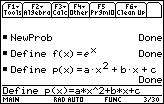
Find the value of c when the two function values are equal at x = 0.
- solve(f(x) = p(x), c) | x=0
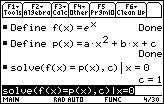
If c = 1, the function and the polynomial have the same value at x = 0, so p(x) = ax2 + bx + 1
Set the first derivatives equal and solve for b when x = 0.
- solve(d(f(x), x) = d(p(x), x), b) | x=0
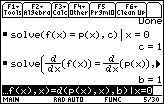
If b = 1, the function and the polynomial will have the same slope at x = 0, so p(x) = ax2 + x + 1.
Set the second derivatives equal and solve for a when x = 0.
- solve(d(f(x), x, 2) = d(p(x), x, 2), a) | x=0
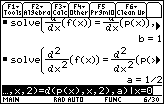
If a = 1/2, the function and the polynomial will have the same concavity at x = 0. Therefore,
p(x) = (1/2)x2 + x + 1 approximates y = ex near x = 0.
Displaying Graphs of the Function and the Approximating Quadratic Polynomial
-
Graph the functions y1 = ex and
 in a [-10, 10] x [-10, 10] window and set the graphing style of y1 = ex to "thick"
in a [-10, 10] x [-10, 10] window and set the graphing style of y1 = ex to "thick"
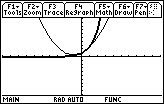
The parabola has the same value, the same slope and the same concavity as y = ex at x = 0. The quadratic polynomial is a good approximation for y = ex at x = 0.
22.2.1 Create a table of values for y = ex and
![]() with tblStart = -1 and
with tblStart = -1 and
![]() tbl = 0.1. Compare the values of y = ex and the quadratic polynomial when x = -0.5 and when x = 0.5.
tbl = 0.1. Compare the values of y = ex and the quadratic polynomial when x = -0.5 and when x = 0.5.
Click here for the answer.
Outlining the General Procedure of Finding Maclaurin Series
The general idea for finding the coefficients of a power series
![]()
that approximates a function
y = f(x)
near x = 0 is first to set the value of the power series equal to the value of f(x) at x = 0 and solve for c0. Then, set all of the derivatives of the power series (beginning with the first) equal to the corresponding derivative of f(x) at x = 0 and solve for the remaining coefficients of the power series.
The series found is this fashion is called the Maclaurin series for f(x).
Letting f (k)(x) represent the kth derivative of f, the coefficient of the term that contains the kth power of x in a Maclaurin series is
![]()
This method produces the following power series for y = ex :
![]()
The Maclaurin series above is more than an approximation of ex, it is equal to ex on the interval of convergence (–
![]() ,
,
![]() ).
).
Every Maclaurin series is centered at 0 and the interval of convergence is centered at 0. When the Maclaurin series approximates a function, the series values and the function values are very close near x = 0.
The partial sum
![]()
is the nth-order Maclaurin polynomial for f.
Generating Maclaurin Polynomials on a TI-89
The TI-89 can generate Maclaurin polynomials for a function f using the taylor( command.
|
|||
|
|
|||
Generate the second-order Maclaurin polynomial for ex using the taylor( command.
- Perform NewProb
-
Open the Calc menu by pressing

- Highlight 9:taylor( by scrolling to the 9th element in the menu
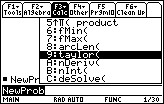
-
Paste taylor( to the Edit Line by pressing

- Execute the command taylor(e^x, x, 2)
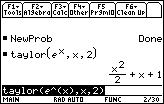
22.2.2 Use the taylor command to find the fifth-order Maclaurin polynomial for
y = ln(1 + x) and interpret the result. Click here for the answer.
22.2.3 Graph y = ln(1 + x) and the fifth-order polynomial from 22.2.2 together. Click here for the answer.